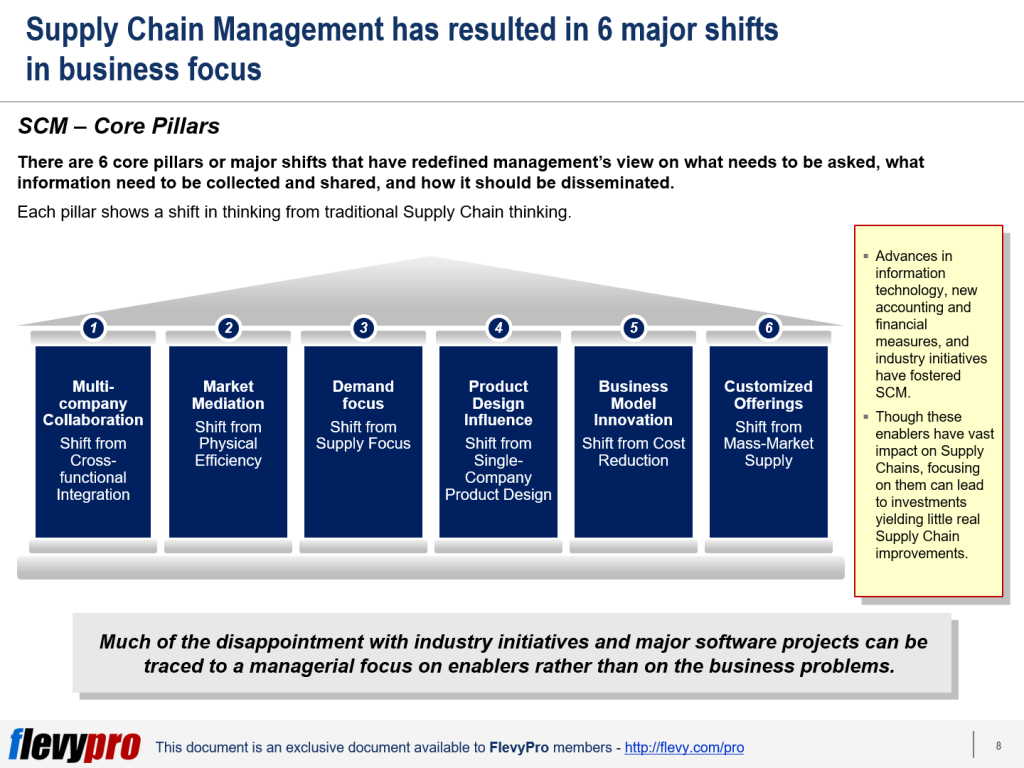Supply chain thinking used to be limited to the managers of a few global companies—companies that were struggling to coordinate  internal information and materials. This, however, led to an exciting boom in cross-business coordination based on Supply Chain Management concepts.
internal information and materials. This, however, led to an exciting boom in cross-business coordination based on Supply Chain Management concepts.
Today, the field has broadened and shifted over time. Current supply chain trends—differentiation, outsourcing, compression, and collaboration—are being used to restructure supply networks and improve coordination. As more companies integrate their networks, capabilities are improving. The levels of product customization and business complexity are also increasing. As this continues, Supply Chain Management is being used in new ways to create uniquely defined customer relationships anchored on appropriate Customer-centric Design.
The field of Supply Chain Management will continue to influence companies. The best way to understand the impact of a long-term trend is to examine how the trend has changed the way executives view their businesses and what issues they choose to focus on.
Rationale Behind Supply Chain Management
Supply Chain Management is the design, planning, execution, control, and monitoring of supply chain activities. It is the management of the flow of goods and services. Essentially, Supply Chain Management addresses the fundamental business problems of supplying products to meet demand in a complex and uncertain world.
Conceptually, Supply Chain Management draws on the value chain concept of business strategist, Michael E. Porter. It conveys the idea of looking at the supply chain issue at the multi-company level.
As the global business environment becomes more complex and competitive, there have been shorter product life cycles and greater product variety. Due to this, it has increased supply chain costs and complexity. The birth and growth of outsourcing, globalization, and business fragmentation has resulted in a crucial need for supply chain integration. Coupled with advances in information technology, this has led to the creation of greater opportunity for Supply Chain Management.
Why is Supply Chain Management essential at this time? There is now an increasing need to create net value, build a competitive infrastructure, leverage worldwide logistics, synchronizing supply with demand, and measure performance globally. Only Supply Chain Management has a systematic process to satisfy these increasing demands.
With the increasing application of Supply Chain Management, there have been shifts in the view of management and influencing Strategy Development.
The 6 Core Pillars of Supply Chain Management Thinking
The 6 Core Pillars of Supply Chain Management Thinking are the major shifts that have redefined management’s view which is far different from traditional Supply Chain thinking.
The first Core Pillar is Multi-company Collaboration. This is the shift from cross-functional integration to multi-company collaboration. Traditionally, Supply Chain thinking was focused on integrating within their companies. But with the new Supply Chain Management perspective, the focus now is on integrating across companies to coordinate and improve supply.
With the shift in thinking, what is asked now is how do we coordinate activities across companies, as well as across internal functions, to supply products to the markets. This is a great deviation from the traditional thinking which ask how do we get the various functional areas of the company to work together to supply product to our immediate customers.
With the first Core Pillar, we get to achieve significant breakthroughs. There are lower supply chain-related costs and improved responsiveness within a chain of companies.
The very essence of Multi-company Collaboration is rethinking how organizations align goals and make decisions.
The other Core Pillars are Market Mediation, Demand Focus, Product Design Influence, Business Model Innovation, and Customized Offerings. Each core pillar is considered an enabler that has a vast impact on Supply Chains.
Interested in gaining more understanding of the 6 pillars of Supply Chain Management (SCM) thinking? You can learn more and download an editable PowerPoint about the 6 Pillars of Supply Chain Management (SCM) Thinking here on the Flevy documents marketplace.
Are you a management consultant?
You can download this and hundreds of other consulting frameworks and consulting training guides from the FlevyPro library.

Comments